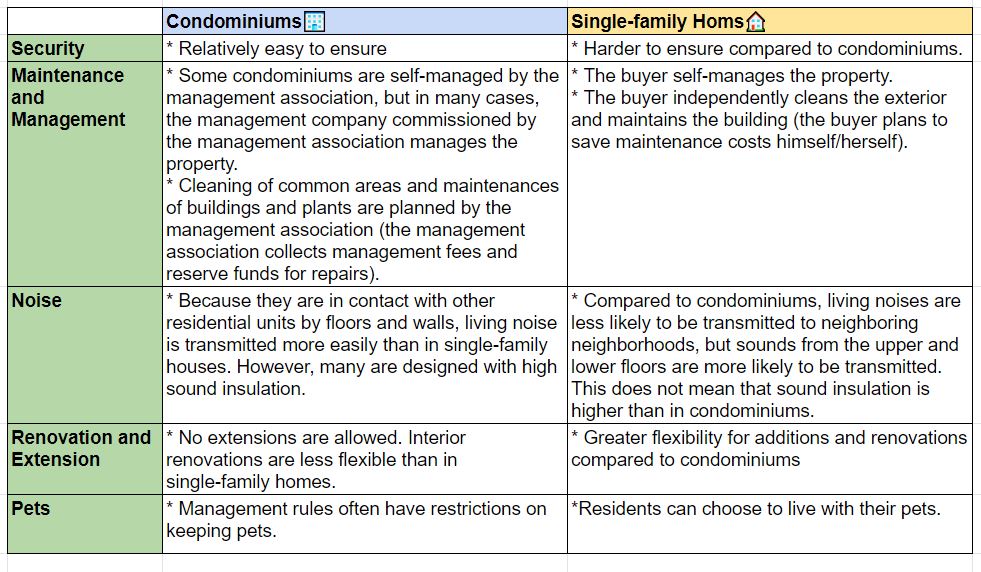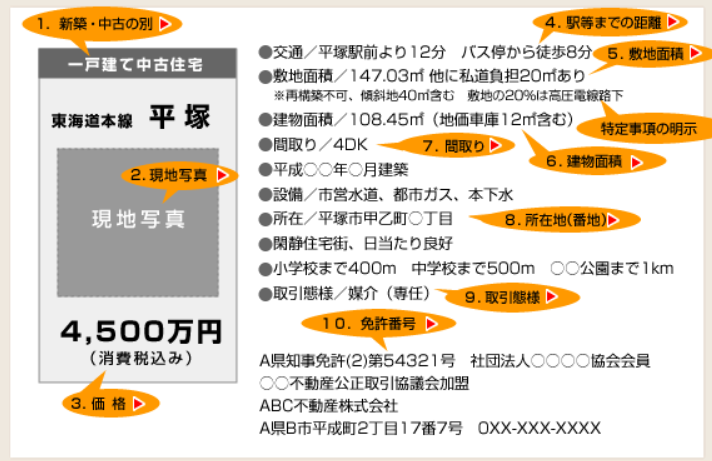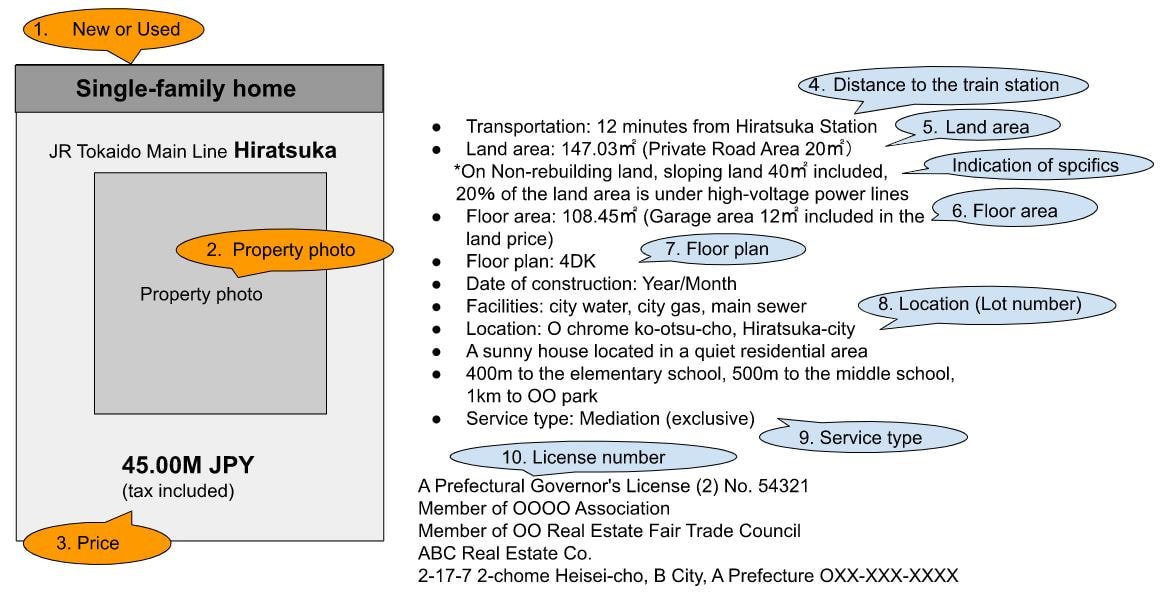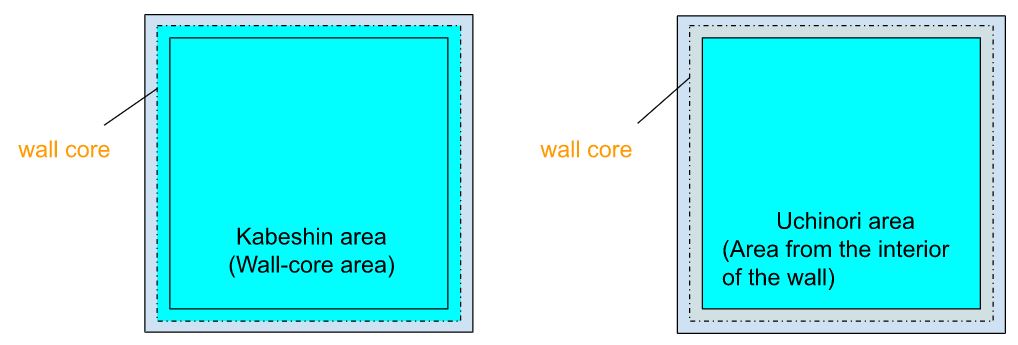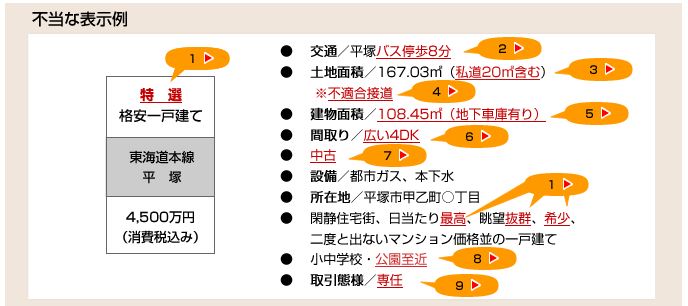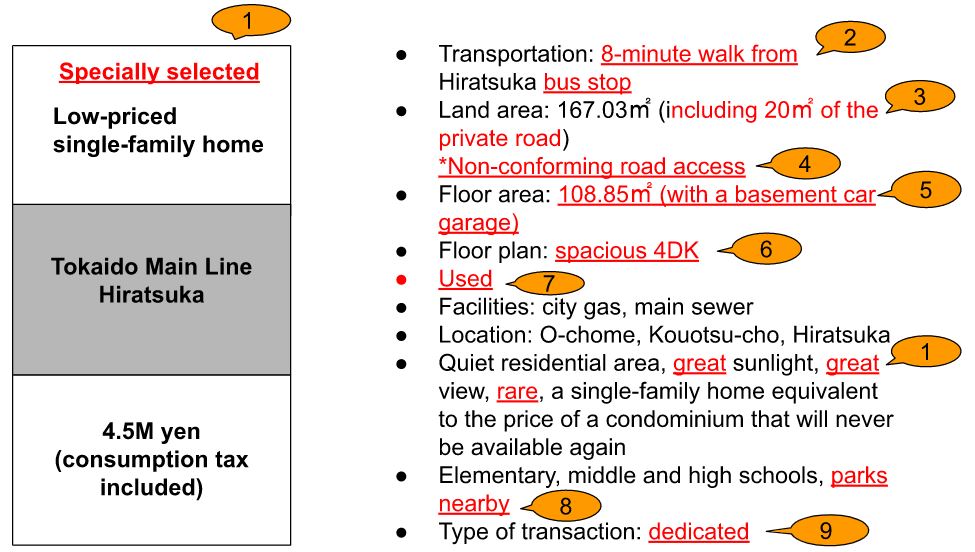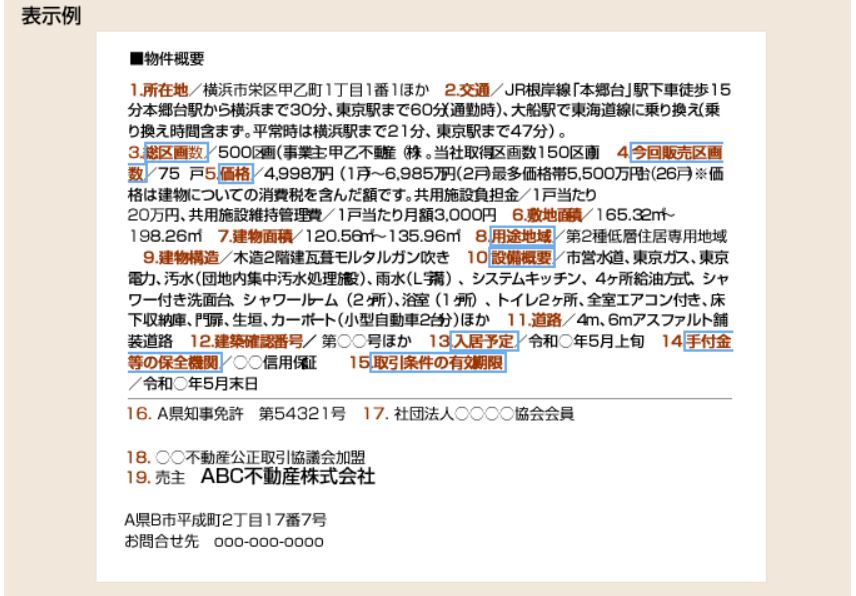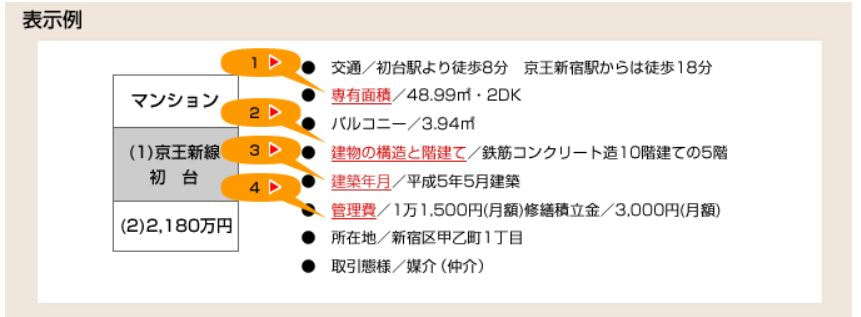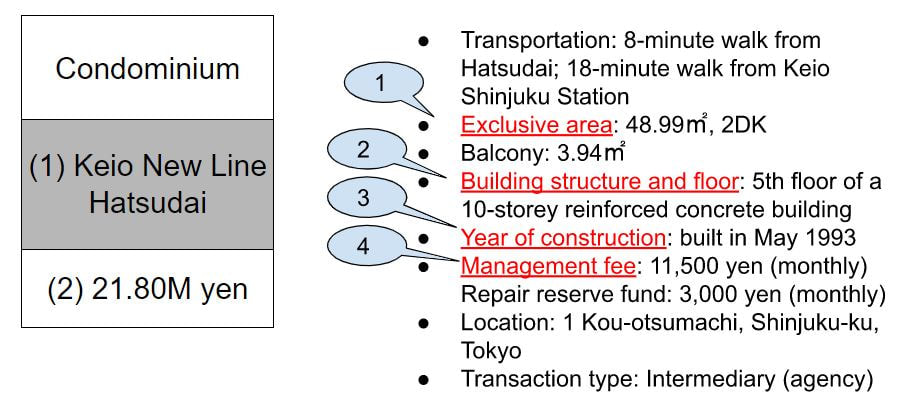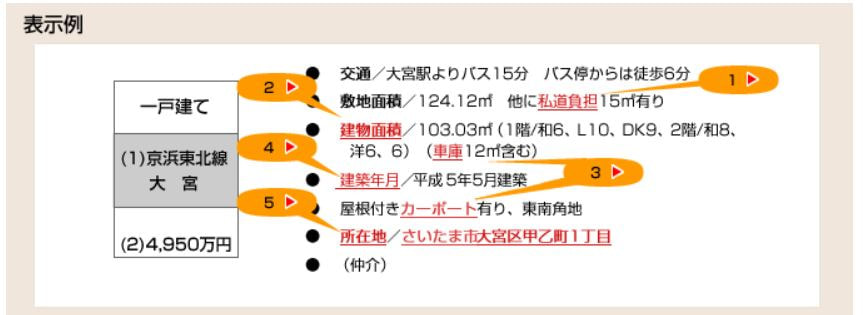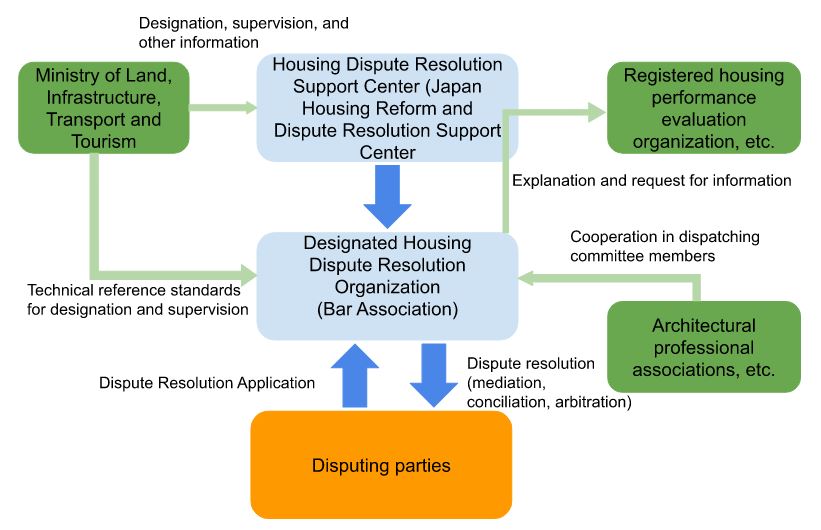Finding a Home
5-1 List up your housing preferences
When purchasing a home, it is necessary to consider whether to buy a condominium or a single-family home, and whether to buy a newly built or used property. It is important to discuss with your family how you would like to live after the purchase, what kind of life you would like to lead, and what kind of home would be best for you to realize your dreams.
Point 1: Envision the life you want to lead.
First, envision what kind of lifestyle you would like to lead.
For example, "you might want a single-family house because you want to keep pets," or "you might want a condominium because it is too much trouble to maintain the garden and exterior," etc. By imagining the kind of life you want to realize in concrete terms, you can find a form of housing that will fulfill that desire.
For example, "you might want a single-family house because you want to keep pets," or "you might want a condominium because it is too much trouble to maintain the garden and exterior," etc. By imagining the kind of life you want to realize in concrete terms, you can find a form of housing that will fulfill that desire.
Point2: Know the characteristics of the property types.
Both condominiums and single-family homes have their own characteristics. Everyone has their own preferences for housing, so use the table below to consider what makes a home comfortable to live in for you.
Condominiums vs. single-family homes
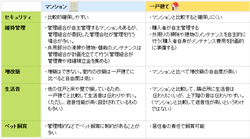
Characteristics of each of newly built and used houses
When looking for a used home, there are several mechanisms in place to address concerns about the quality of older buildings. These include the following methods to check the quality of an existing house.
- Inspection: An objective inspection and investigation of the condition of a building by a third-party expert who conducts a building diagnosis.
- Housing Performance Evaluation System: A system in which housing performance is evaluated on a scale of 1 to 5 by a third-party housing performance evaluation organization registered by the Minister of Land, Infrastructure, Transport and Tourism.
- Safe R-Housing: A used house that is earthquake resistant and has undergone inspections such as building condition surveys, and for which information on remodeling, etc. is provided. The Ministry of Land, Infrastructure, Transport and Tourism examines and registers the business groups that wish to participate in this program, and the businesses (real estate companies, etc.) that belong to each business group list the used housing that meets their standards as "Safe R-Housing" in their advertisements and other media.
Point3: Understanding condominium management
(1) Exclusive and common areas
A condominium differs significantly from a single-family home in that the property is co-owned by the owners of each unit: unit ownership. While the site is co-owned by all unit owners/purchasers, the building is divided into "exclusive use" and "common use" areas. Exclusive areas are the living space inside the house that is partitioned off by walls and ceilings and are owned by the owner. Common areas are the entrances to the entire building, elevators, stairs, corridors, exterior walls, bicycle parking lots, garbage storage areas, etc., which are shared by all condominium unit owners.
A condominium differs significantly from a single-family home in that the property is co-owned by the owners of each unit: unit ownership. While the site is co-owned by all unit owners/purchasers, the building is divided into "exclusive use" and "common use" areas. Exclusive areas are the living space inside the house that is partitioned off by walls and ceilings and are owned by the owner. Common areas are the entrances to the entire building, elevators, stairs, corridors, exterior walls, bicycle parking lots, garbage storage areas, etc., which are shared by all condominium unit owners.
(2) The role of the management association
The common areas are managed by a management association whose members are all condominium unit owners. The management association decides on management policies, such as a long-term repair plan, including when and how to inspect and repair the buildings and facilities in the common areas, and all unit owners accumulate the necessary expenses for this purpose (called a repair reserve fund). In general, the daily cleaning of common areas is carried out by a management company entrusted by the management association.
The common areas are managed by a management association whose members are all condominium unit owners. The management association decides on management policies, such as a long-term repair plan, including when and how to inspect and repair the buildings and facilities in the common areas, and all unit owners accumulate the necessary expenses for this purpose (called a repair reserve fund). In general, the daily cleaning of common areas is carried out by a management company entrusted by the management association.
(3) Management regulations and bylaws for use
A condominium is a place for communal living, and rules are necessary to ensure that everyone can live comfortably together. These rules are called the management regulations and bylaws for use.
The management regulations mainly stipulate the operation of the management association, and includes the scope of exclusive areas and common areas, the amount of management fees and reserve funds for repairs, and whether or not pets are allowed. The bylaws for use stipulate the rules and promises for daily life in the condominium, such as how to use the balcony.
A condominium is a place for communal living, and rules are necessary to ensure that everyone can live comfortably together. These rules are called the management regulations and bylaws for use.
The management regulations mainly stipulate the operation of the management association, and includes the scope of exclusive areas and common areas, the amount of management fees and reserve funds for repairs, and whether or not pets are allowed. The bylaws for use stipulate the rules and promises for daily life in the condominium, such as how to use the balcony.
5-2How to Read Real Estate Advertisements (Basics)
Since real estate advertisements contain a lot of information about individual properties, you need to properly understand the information in the advertisements when considering properties to buy.
Point 1: Property search starts with gathering a wide range of information.
To find a desired property, the first step is to gather information on a wide range of properties that might meet your requirements through the Internet, information magazines, newspaper inserts, and other means. Therefore, it is important to understand how to read the advertisements in order to correctly understand the contents listed in these publications.
∙ Search for information on condominiums, single-family homes, and commercial properties
∙ Search for information on condominiums, single-family homes, and commercial properties
Point 2: All you need to know about real estate advertising terms and conditions
Real estate advertisements are subject to a number of regulations regarding the method of display, etc., for the purpose of consumer protection.
One is the regulation under the Real Estate Brokerage Act, which prohibits exaggerated advertisements and restricts when advertisements can be started. In addition, the "Fair Competition Code Concerning Real Estate Representation" ("Representation Code"), an industry self-regulation approved by the Fair Trade Commission, defines the manner and standards for displaying advertisements.
One is the regulation under the Real Estate Brokerage Act, which prohibits exaggerated advertisements and restricts when advertisements can be started. In addition, the "Fair Competition Code Concerning Real Estate Representation" ("Representation Code"), an industry self-regulation approved by the Fair Trade Commission, defines the manner and standards for displaying advertisements.
Basic Real Estate Advertising Rules and Regulations
The listing terms and conditions define the items that must be displayed in real estate advertisements and the standards for displaying them. The basic terms and conditions are shown in the chart below.
The listing terms and conditions define the items that must be displayed in real estate advertisements and the standards for displaying them. The basic terms and conditions are shown in the chart below.
*The above example is for general newspaper and magazine advertisements.
1. New or Used
In real estate advertisements, the property is indicated as "new" when it is less than one year old and has not been occupied (no one has ever lived in the property). All other properties are indicated as "used."
2. Property photo
As a general rule, photographs must be used in advertisements only if they are of a building that is actually for sale. However, if the building has not yet been completed, photographs of other properties may be used as long as they are identical to the building actually for sale, and this fact needs to be clearly stated.
3. Price
The price including consumption tax for the building is displayed.
4. Distance to the train station, etc.
The time required on foot is calculated as 1 minute (rounded up to the nearest minute) for every 80 meters of road distance from the station. The time required for waiting at traffic lights, going up and down pedestrian bridges, going up and down hills, crossing roads, etc. are not taken into account. In addition, the time required to reach the platform may be longer because it is based on the nearest station entrance to the property, not from the ticket gate.
5. Land area
The area is displayed in units of square meters, and may not be displayed in units of "tsubo". The area indicated in square meters is divided by 3.3 to obtain the approximate area in tsubo.
6. Floor Area
The total floor area is shown in square meters. If a basement or garage is included, a statement to that effect and the area of the basement or garage are to be indicated. Balconies in condominiums and two-tiered attic storage with high ceilings in the rooms are not included in the area.
In principle, the floor area of a building is indicated by the "kabeshin" (wall-core) area measured from the center of the wall, but the area on the registration record (registry) is indicated by the "uchinori" area measured from the inside of the wall (interior side). However, for used condominiums, the internal area on the registration record (registry book) may be indicated.
In real estate advertisements, the property is indicated as "new" when it is less than one year old and has not been occupied (no one has ever lived in the property). All other properties are indicated as "used."
2. Property photo
As a general rule, photographs must be used in advertisements only if they are of a building that is actually for sale. However, if the building has not yet been completed, photographs of other properties may be used as long as they are identical to the building actually for sale, and this fact needs to be clearly stated.
3. Price
The price including consumption tax for the building is displayed.
4. Distance to the train station, etc.
The time required on foot is calculated as 1 minute (rounded up to the nearest minute) for every 80 meters of road distance from the station. The time required for waiting at traffic lights, going up and down pedestrian bridges, going up and down hills, crossing roads, etc. are not taken into account. In addition, the time required to reach the platform may be longer because it is based on the nearest station entrance to the property, not from the ticket gate.
5. Land area
The area is displayed in units of square meters, and may not be displayed in units of "tsubo". The area indicated in square meters is divided by 3.3 to obtain the approximate area in tsubo.
6. Floor Area
The total floor area is shown in square meters. If a basement or garage is included, a statement to that effect and the area of the basement or garage are to be indicated. Balconies in condominiums and two-tiered attic storage with high ceilings in the rooms are not included in the area.
In principle, the floor area of a building is indicated by the "kabeshin" (wall-core) area measured from the center of the wall, but the area on the registration record (registry) is indicated by the "uchinori" area measured from the inside of the wall (interior side). However, for used condominiums, the internal area on the registration record (registry book) may be indicated.
7. Floor plan
When describing a floor plan, indications such as 4LDK are often used. The numbers represent the number of bedrooms, L represents the living room, D represents the dining room, and K represents the kitchen. According to the Building Standard Law, bedrooms must have a certain amount of frontage for lighting and ventilation, so rooms that do not meet these requirements are labeled as a storage room (N) or service room (S). The indication code stipulates that 1 tatami mat, which indicates the size of a living room, is converted to a minimum of 1.62㎡.
8. Location (Lot number)
The location of the property is indicated up to the lot number in the case of a newly built house for sale. In the case of an existing house, the lot number can be omitted, so it is often not indicated. In addition, the lot number is the number indicated in the registration record (registry), which may differ from the commonly used residential number.
9. Service type
Whether the position of the real estate company which publishes an advertisement is "Seller" or "Agency" or "Mediation (agency)" is always clearly indicated. This transaction mode determines whether a mediating fee is necessary or not. Moreover, there is general mediation, full-time mediation, etc. in mediation, but in the case of full-time mediation, an indication like mediation (full-time) is permitted.
10. License number
The name of the real estate company and its license number are listed so that you can confirm that the company has received the necessary licenses for real estate transactions. The number in parentheses indicates the number of times the license has been renewed, and the higher the number, the longer the company has been in business.
When describing a floor plan, indications such as 4LDK are often used. The numbers represent the number of bedrooms, L represents the living room, D represents the dining room, and K represents the kitchen. According to the Building Standard Law, bedrooms must have a certain amount of frontage for lighting and ventilation, so rooms that do not meet these requirements are labeled as a storage room (N) or service room (S). The indication code stipulates that 1 tatami mat, which indicates the size of a living room, is converted to a minimum of 1.62㎡.
8. Location (Lot number)
The location of the property is indicated up to the lot number in the case of a newly built house for sale. In the case of an existing house, the lot number can be omitted, so it is often not indicated. In addition, the lot number is the number indicated in the registration record (registry), which may differ from the commonly used residential number.
9. Service type
Whether the position of the real estate company which publishes an advertisement is "Seller" or "Agency" or "Mediation (agency)" is always clearly indicated. This transaction mode determines whether a mediating fee is necessary or not. Moreover, there is general mediation, full-time mediation, etc. in mediation, but in the case of full-time mediation, an indication like mediation (full-time) is permitted.
10. License number
The name of the real estate company and its license number are listed so that you can confirm that the company has received the necessary licenses for real estate transactions. The number in parentheses indicates the number of times the license has been renewed, and the higher the number, the longer the company has been in business.
Specific matters that must be clearly indicated
If the use of land is subject to legal restrictions or the shape of the land is so irregular that it cannot be used effectively, this fact is clearly indicated in the advertisement. The specific items that must be clearly indicated in real estate advertisements are as follows.
1. Land in an urbanization control area
In principle, land cannot be developed or buildings cannot be constructed within the urbanization control area designated in the city plan, and this fact must be clearly indicated.
2. Land that does not legally abut a road
Land that does not abut a road of 2 meters or more as stipulated by the Building Standards Law cannot be used for buildings. Such land is labeled as " no building allowed" or, in the case of an existing house, as " no rebuilding allowed."
3. Land requiring setback (road setback)
Setback means that when the width of the road bordering the land is less than 4m, the land is set back 2m from the center of the road to construct a building. The setback is considered to be the road and no building can be constructed. The land that requires a setback is indicated as such. If the area of the setback required is approximately 10% or more of the total area of the land, the area is also indicated.
4. Land with an old house, etc.
When there is an old house or an abandoned house on the land that is the subject of the transaction, it is indicated as "There is an old house" or "There is an abandoned house" etc.
5. Land under high-voltage lines
When all or part of the land is under high voltage lines, a statement to that effect and the approximate area of the land must be indicated. When the construction of buildings or other structures is prohibited, the indication will read, for example, "No buildings or other structures are allowed under the high-voltage lines.
6. Land with slopes and significantly irregularly shaped land
In the case of land that includes sloping land and the ratio of sloping land is approximately 30% or more, or even if the ratio is less than 30%, the fact that the land includes sloping land and its area is indicated if the effective use of the land is significantly hindered by the inclusion of sloping land, etc. In addition, the fact that the land is significantly irregularly shaped and hinders effective use of the land is also indicated. In the case of a markedly irregularly shaped lot, etc., which prevents the effective use of land, a statement to that effect is also indicated.
7. Land on or under a cliff not covered by a retaining wall
If the land is on or under a cliff that is not covered by a retaining wall, this must be indicated.
8. Land with building conditions
Land with building conditions is land that is sold or purchased on the condition that a building contract will be concluded with the seller of the land or a construction company designated by the seller within a certain period of time after the contract is concluded. The details of the building conditions and the measures to be taken if the building contract is not concluded are to be clearly indicated.
Specific matters that must be clearly indicated
If the use of land is subject to legal restrictions or the shape of the land is so irregular that it cannot be used effectively, this fact is clearly indicated in the advertisement. The specific items that must be clearly indicated in real estate advertisements are as follows.
1. Land in an urbanization control area
In principle, land cannot be developed or buildings cannot be constructed within the urbanization control area designated in the city plan, and this fact must be clearly indicated.
2. Land that does not legally abut a road
Land that does not abut a road of 2 meters or more as stipulated by the Building Standards Law cannot be used for buildings. Such land is labeled as " no building allowed" or, in the case of an existing house, as " no rebuilding allowed."
3. Land requiring setback (road setback)
Setback means that when the width of the road bordering the land is less than 4m, the land is set back 2m from the center of the road to construct a building. The setback is considered to be the road and no building can be constructed. The land that requires a setback is indicated as such. If the area of the setback required is approximately 10% or more of the total area of the land, the area is also indicated.
4. Land with an old house, etc.
When there is an old house or an abandoned house on the land that is the subject of the transaction, it is indicated as "There is an old house" or "There is an abandoned house" etc.
5. Land under high-voltage lines
When all or part of the land is under high voltage lines, a statement to that effect and the approximate area of the land must be indicated. When the construction of buildings or other structures is prohibited, the indication will read, for example, "No buildings or other structures are allowed under the high-voltage lines.
6. Land with slopes and significantly irregularly shaped land
In the case of land that includes sloping land and the ratio of sloping land is approximately 30% or more, or even if the ratio is less than 30%, the fact that the land includes sloping land and its area is indicated if the effective use of the land is significantly hindered by the inclusion of sloping land, etc. In addition, the fact that the land is significantly irregularly shaped and hinders effective use of the land is also indicated. In the case of a markedly irregularly shaped lot, etc., which prevents the effective use of land, a statement to that effect is also indicated.
7. Land on or under a cliff not covered by a retaining wall
If the land is on or under a cliff that is not covered by a retaining wall, this must be indicated.
8. Land with building conditions
Land with building conditions is land that is sold or purchased on the condition that a building contract will be concluded with the seller of the land or a construction company designated by the seller within a certain period of time after the contract is concluded. The details of the building conditions and the measures to be taken if the building contract is not concluded are to be clearly indicated.
If the use of land is subject to legal restrictions or the shape of the land is so irregular that it cannot be used effectively, this fact is clearly indicated in the advertisement. The specific items that must be clearly indicated in real estate advertisements are as follows.
1. Land in an urbanization control area
In principle, land cannot be developed or buildings cannot be constructed within the urbanization control area designated in the city plan, and this fact must be clearly indicated.
2. Land that does not legally abut a road
Land that does not abut a road of 2 meters or more as stipulated by the Building Standards Law cannot be used for buildings. Such land is labeled as " no building allowed" or, in the case of an existing house, as " no rebuilding allowed."
3. Land requiring setback (road setback)
Setback means that when the width of the road bordering the land is less than 4m, the land is set back 2m from the center of the road to construct a building. The setback is considered to be the road and no building can be constructed. The land that requires a setback is indicated as such. If the area of the setback required is approximately 10% or more of the total area of the land, the area is also indicated.
4. Land with an old house, etc.
When there is an old house or an abandoned house on the land that is the subject of the transaction, it is indicated as "There is an old house" or "There is an abandoned house" etc.
5. Land under high-voltage lines
When all or part of the land is under high voltage lines, a statement to that effect and the approximate area of the land must be indicated. When the construction of buildings or other structures is prohibited, the indication will read, for example, "No buildings or other structures are allowed under the high-voltage lines.
6. Land with slopes and significantly irregularly shaped land
In the case of land that includes sloping land and the ratio of sloping land is approximately 30% or more, or even if the ratio is less than 30%, the fact that the land includes sloping land and its area is indicated if the effective use of the land is significantly hindered by the inclusion of sloping land, etc. In addition, the fact that the land is significantly irregularly shaped and hinders effective use of the land is also indicated. In the case of a markedly irregularly shaped lot, etc., which prevents the effective use of land, a statement to that effect is also indicated.
7. Land on or under a cliff not covered by a retaining wall
If the land is on or under a cliff that is not covered by a retaining wall, this must be indicated.
8. Land with building conditions
Land with building conditions is land that is sold or purchased on the condition that a building contract will be concluded with the seller of the land or a construction company designated by the seller within a certain period of time after the contract is concluded. The details of the building conditions and the measures to be taken if the building contract is not concluded are to be clearly indicated.
Specific matters that must be clearly indicated
If the use of land is subject to legal restrictions or the shape of the land is so irregular that it cannot be used effectively, this fact is clearly indicated in the advertisement. The specific items that must be clearly indicated in real estate advertisements are as follows.
1. Land in an urbanization control area
In principle, land cannot be developed or buildings cannot be constructed within the urbanization control area designated in the city plan, and this fact must be clearly indicated.
2. Land that does not legally abut a road
Land that does not abut a road of 2 meters or more as stipulated by the Building Standards Law cannot be used for buildings. Such land is labeled as " no building allowed" or, in the case of an existing house, as " no rebuilding allowed."
3. Land requiring setback (road setback)
Setback means that when the width of the road bordering the land is less than 4m, the land is set back 2m from the center of the road to construct a building. The setback is considered to be the road and no building can be constructed. The land that requires a setback is indicated as such. If the area of the setback required is approximately 10% or more of the total area of the land, the area is also indicated.
4. Land with an old house, etc.
When there is an old house or an abandoned house on the land that is the subject of the transaction, it is indicated as "There is an old house" or "There is an abandoned house" etc.
5. Land under high-voltage lines
When all or part of the land is under high voltage lines, a statement to that effect and the approximate area of the land must be indicated. When the construction of buildings or other structures is prohibited, the indication will read, for example, "No buildings or other structures are allowed under the high-voltage lines.
6. Land with slopes and significantly irregularly shaped land
In the case of land that includes sloping land and the ratio of sloping land is approximately 30% or more, or even if the ratio is less than 30%, the fact that the land includes sloping land and its area is indicated if the effective use of the land is significantly hindered by the inclusion of sloping land, etc. In addition, the fact that the land is significantly irregularly shaped and hinders effective use of the land is also indicated. In the case of a markedly irregularly shaped lot, etc., which prevents the effective use of land, a statement to that effect is also indicated.
7. Land on or under a cliff not covered by a retaining wall
If the land is on or under a cliff that is not covered by a retaining wall, this must be indicated.
8. Land with building conditions
Land with building conditions is land that is sold or purchased on the condition that a building contract will be concluded with the seller of the land or a construction company designated by the seller within a certain period of time after the contract is concluded. The details of the building conditions and the measures to be taken if the building contract is not concluded are to be clearly indicated.
5-3 How to Read Real Estate Advertisements (Prohibited Matters)
In real estate advertising, "bait and switch" and "misleading representations" are prohibited.
Take a look at the display examples to see if there are any violations of the terms and conditions that should be displayed, such as missing items or misleading wording.
In real estate advertising, "bait and switch" and "misleading representations" are prohibited.
Take a look at the display examples to see if there are any violations of the terms and conditions that should be displayed, such as missing items or misleading wording.
Point 1: Beware of bait-and-switch advertisements, etc.
A bait-and-switch advertisement is an advertisement for a property that cannot be traded and includes the following:
- Fictitious properties
- Properties that have already been sold
- Properties with no intention of selling
Point2: Misrepresentation in real estate advertising you should know about
*This example is for newspaper inserts. Examples of company name, building license number, name of organization, company address, etc. are omitted.
Examples of misrepresentation
1. "Specially Selected," "Best," "Outstanding," "Rare," etc.
In addition to terms such as "specially selected" that indicate that the real estate has been selected according to certain criteria, terms that give the impression of extremely low prices ("cheap", etc.), terms that imply superiority over other companies ("first in the industry", "best in Japan", etc.), and terms that indicate the highest quality are prohibited unless there is objective and concrete evidence to support the use.
2. 8-minute walk from the bus stop
The time required to take a bus from the nearest station to the nearest bus stop and the time required to walk from the bus stop to the property must be indicated.
3. 20㎡ private road included
The property area and the private road area (if any) must be indicated clearly and separately.
4. Non-conforming road access
When a building is constructed in a city planning area or a quasi-city planning area, the site must, in principle, abut a 4m or wider road under the Building Standard Law by at least 2m. In the case of a "non-conforming road" that does not meet this requirement, the property must be marked as "no building allowed" or "no re-building allowed.
5. Floor area: 108.45㎡ (with a basement car garage)
A car garage cannot be included in the floor area.
6. Spacious 4DK
Subjective expressions such as "spacious" and "bright" are prohibited.
7. Used
The date of construction must be indicated.
8. Proximity to parks
When indicating public facilities such as schools and parks, the distance must be clearly indicated instead of using subjective expressions such as "close by.
9. Dedicated service
It is necessary to clearly indicate the real estate company's position on transactions by specifying which of "seller," "lessor," "mediation," and "agency" corresponds to the transaction mode.
1. "Specially Selected," "Best," "Outstanding," "Rare," etc.
In addition to terms such as "specially selected" that indicate that the real estate has been selected according to certain criteria, terms that give the impression of extremely low prices ("cheap", etc.), terms that imply superiority over other companies ("first in the industry", "best in Japan", etc.), and terms that indicate the highest quality are prohibited unless there is objective and concrete evidence to support the use.
2. 8-minute walk from the bus stop
The time required to take a bus from the nearest station to the nearest bus stop and the time required to walk from the bus stop to the property must be indicated.
3. 20㎡ private road included
The property area and the private road area (if any) must be indicated clearly and separately.
4. Non-conforming road access
When a building is constructed in a city planning area or a quasi-city planning area, the site must, in principle, abut a 4m or wider road under the Building Standard Law by at least 2m. In the case of a "non-conforming road" that does not meet this requirement, the property must be marked as "no building allowed" or "no re-building allowed.
5. Floor area: 108.45㎡ (with a basement car garage)
A car garage cannot be included in the floor area.
6. Spacious 4DK
Subjective expressions such as "spacious" and "bright" are prohibited.
7. Used
The date of construction must be indicated.
8. Proximity to parks
When indicating public facilities such as schools and parks, the distance must be clearly indicated instead of using subjective expressions such as "close by.
9. Dedicated service
It is necessary to clearly indicate the real estate company's position on transactions by specifying which of "seller," "lessor," "mediation," and "agency" corresponds to the transaction mode.
5-4 How to Read a Real Estate Advertisement: Property Section
Real estate advertising is also regulated by property types. Take a look at some important points to consider when looking at advertisements for newly built properties for sale, used condominiums, and used single-family homes.
Real estate advertising is also regulated by property types. Take a look at some important points to consider when looking at advertisements for newly built properties for sale, used condominiums, and used single-family homes.
Point 1: Real estate checkpoints: new construction for sale
It is important to confirm that the number of units for sale and prices are viewed differently for newly constructed properties for sale than for existing properties because, for example, several properties are sold at once in the same residential development area or condominium.
Display example:
Property Overview
1. Location: 1-1-1 Ko-otsu-machi Sakae-ku, Yokohama
2. Transportation:
5. Prices: 49.98M JPY (x 1)ー69.85M JPY (x 2): 26 are in the price ranges of around 55.00 JPY
*Prices include sales tax on buildings.
Common facility contribution fee: ¥200,000 per unit
Common facility maintenance fee: ¥3,000 per unit per month.
6. Land area: 165.32㎡ー198.26㎡
7. Floor area: 120.56㎡ー135.96㎡
8. Zoning: Type 2 low-rise residential zone
9. Building structure: 2-story wooden building with a tiled roof (mortar sprayed)
10. Facilities: city water supply, Tokyo Gas, Tokyo Electric Power Company, sewage (centralized sewage treatment facility in the complex), rainwater (L-shaped ditch), system kitchen, 4-position fueling system, shampoo vanity, shower room (2 locations), bathroom (1 location), 2 toilets, air conditioning in all rooms, under-floor storage, gate, hedge, roofed car garage (for 2 compact cars), etc.
11. Road: facing the 4 meter-wide asphalt paved road for 6 meters
12. Building Permit Number: No. OO
13. Scheduled move-in: Early May of Year
14. Deposit security institution: OO Credit Guarantor
15 . Expiration Date of Terms and Conditions: the end of May of Year
16. Licensed by the Governor of Prefecture A, No. 54321
17. Member of OOOO Association
18. Member of OO Real Estate Fair Trade Council
19. Seller: ABC Real Estate Co.
2-17-7 Heisei-cho B City, A Prefecture
Phone* OOO-OOO-OOOO
*This example is for general newspaper and magazine advertisements.
Property Overview
1. Location: 1-1-1 Ko-otsu-machi Sakae-ku, Yokohama
2. Transportation:
- 15-minute walk from Hongodai Station of the JR Negishi Line
- 30 minutes from Hongodai to Yokohama and 60 minutes to Tokyo Station during commuting hours, by transferring to the Tokaido Line at Ofuna Station, not including transfer time (21 min. to Yokohama and 47 min. to Tokyo during non-rush hours).
- 500 plots (Proprietor: Kou Otsu Real Estate Co., Ltd.)
- Number of plots acquired by our company: 150 plots
5. Prices: 49.98M JPY (x 1)ー69.85M JPY (x 2): 26 are in the price ranges of around 55.00 JPY
*Prices include sales tax on buildings.
Common facility contribution fee: ¥200,000 per unit
Common facility maintenance fee: ¥3,000 per unit per month.
6. Land area: 165.32㎡ー198.26㎡
7. Floor area: 120.56㎡ー135.96㎡
8. Zoning: Type 2 low-rise residential zone
9. Building structure: 2-story wooden building with a tiled roof (mortar sprayed)
10. Facilities: city water supply, Tokyo Gas, Tokyo Electric Power Company, sewage (centralized sewage treatment facility in the complex), rainwater (L-shaped ditch), system kitchen, 4-position fueling system, shampoo vanity, shower room (2 locations), bathroom (1 location), 2 toilets, air conditioning in all rooms, under-floor storage, gate, hedge, roofed car garage (for 2 compact cars), etc.
11. Road: facing the 4 meter-wide asphalt paved road for 6 meters
12. Building Permit Number: No. OO
13. Scheduled move-in: Early May of Year
14. Deposit security institution: OO Credit Guarantor
15 . Expiration Date of Terms and Conditions: the end of May of Year
16. Licensed by the Governor of Prefecture A, No. 54321
17. Member of OOOO Association
18. Member of OO Real Estate Fair Trade Council
19. Seller: ABC Real Estate Co.
2-17-7 Heisei-cho B City, A Prefecture
Phone* OOO-OOO-OOOO
*This example is for general newspaper and magazine advertisements.
Total Number of Lots and Number of Units to be Sold (Total Number of Units and Number of Units to be Sold)
The total number of lots is the number of all lots in the area to be developed, and the total number of units is the number of houses/condominiums scheduled to be sold. In the case of large-scale subdivisions, sales are often staggered and divided into several phases, and the number of lots and units to be sold at this time indicates the number of lots and units that are to be sold at the time of advertisement.
Price and Other Costs
Prices must in principle be shown for all properties, but when a large number of properties are to be sold, the lowest, highest, and most expensive price ranges and the number of properties in those price ranges will be shown. The prices also include costs for water, sewerage facilities and city gas supply facilities.
In addition, if there are other charges for common facilities or special facilities, and if there are maintenance and management fees for those facilities, the details and amounts of those fees will be displayed.
Zoning (common to all properties)
The zoning of the property location is displayed. The zoning district is a designation under the City Planning Act that restricts the buildings that can be built and their uses, and defines the use of land in each area. There are a total of 13 zoning districts, and the Building Standards Law defines restrictions on buildings that can be constructed, the building-to-land ratio, and the floor-area ratio for each of these zoning districts.
Facilities Overview (common to all properties)
An overview of facilities such as water and sewage facilities and gas is displayed.
Anticipated Move-in Date and Construction Date
In the case of a newly constructed property for sale, the expected move-in date will be listed if the building is not yet completed, and the construction date is listed if the building has been completed.
Agency for the Preservation of Deposits, etc.
When a real estate company (real estate transaction agent) acts as the seller itself and a deposit, etc. in excess of a certain amount (5% of the amount of the price or in excess of 10 million yen in the case of a purchase and sale before completion of construction, or 10% of the amount of the price or in excess of 10 million yen in the case of a purchase and sale after completion of construction) is paid at the time of the sales contract, the seller must take measures to preserve the deposit received. The measures to preserve the deposit, etc. may include a guarantee by a guarantee company, etc. or insurance by an insurance company, etc. This prevents the buyer from being unable to recover the deposit paid in the event of the seller's bankruptcy before delivery. The agency that implements the security measures can be confirmed in the advertisement.
Expiration Date of Terms and Conditions
In the case of newspaper inserts, etc., the expiration date of the terms and conditions is displayed. In the case of Internet, the information update date is displayed. Properties with good conditions tend to attract buyers quickly, so it is important to check the validity period of the terms and conditions as well as the date when the information is updated.
The total number of lots is the number of all lots in the area to be developed, and the total number of units is the number of houses/condominiums scheduled to be sold. In the case of large-scale subdivisions, sales are often staggered and divided into several phases, and the number of lots and units to be sold at this time indicates the number of lots and units that are to be sold at the time of advertisement.
Price and Other Costs
Prices must in principle be shown for all properties, but when a large number of properties are to be sold, the lowest, highest, and most expensive price ranges and the number of properties in those price ranges will be shown. The prices also include costs for water, sewerage facilities and city gas supply facilities.
In addition, if there are other charges for common facilities or special facilities, and if there are maintenance and management fees for those facilities, the details and amounts of those fees will be displayed.
Zoning (common to all properties)
The zoning of the property location is displayed. The zoning district is a designation under the City Planning Act that restricts the buildings that can be built and their uses, and defines the use of land in each area. There are a total of 13 zoning districts, and the Building Standards Law defines restrictions on buildings that can be constructed, the building-to-land ratio, and the floor-area ratio for each of these zoning districts.
Facilities Overview (common to all properties)
An overview of facilities such as water and sewage facilities and gas is displayed.
Anticipated Move-in Date and Construction Date
In the case of a newly constructed property for sale, the expected move-in date will be listed if the building is not yet completed, and the construction date is listed if the building has been completed.
Agency for the Preservation of Deposits, etc.
When a real estate company (real estate transaction agent) acts as the seller itself and a deposit, etc. in excess of a certain amount (5% of the amount of the price or in excess of 10 million yen in the case of a purchase and sale before completion of construction, or 10% of the amount of the price or in excess of 10 million yen in the case of a purchase and sale after completion of construction) is paid at the time of the sales contract, the seller must take measures to preserve the deposit received. The measures to preserve the deposit, etc. may include a guarantee by a guarantee company, etc. or insurance by an insurance company, etc. This prevents the buyer from being unable to recover the deposit paid in the event of the seller's bankruptcy before delivery. The agency that implements the security measures can be confirmed in the advertisement.
Expiration Date of Terms and Conditions
In the case of newspaper inserts, etc., the expiration date of the terms and conditions is displayed. In the case of Internet, the information update date is displayed. Properties with good conditions tend to attract buyers quickly, so it is important to check the validity period of the terms and conditions as well as the date when the information is updated.
Point 2: Real estate checkpoints: used condominiums
*These examples are for general newspaper and magazine advertisements. Examples of company name, building license number, name of organization, company address, etc. are omitted.
1. Exclusive Area
This is the area of the portion owned by the buyer. In principle, the wall-core area measured from the center of the wall is indicated, but in the case of an existing condominium, the area may be indicated by the area of the registration record (registry) measured from the inside of the wall. Balconies are common areas, so their area is not included in the exclusive area.
2. Building Structure and Stories
Indication of the building structure may be omitted. The phrase "5th floor of a 10-story building" indicates that the condominium building is 10 stories high and the house being sold is on the 5th floor.
3. Year and Month of Construction
The year and month when the building was completed are indicated, rather than the year of construction. Even if the property has never been occupied, if more than one year has passed since construction, it is treated as a used property in real estate advertisements.
4. Management Fee (common to all condominiums)
The monthly management fee and reserve for repairs are shown. In addition, there may be fees for parking, trunk room, and private garden. In addition, the management system may be displayed as "Resident" (when a janitor is stationed at the property), "Day shift (commuting)" (when a janitor is stationed only during the daytime), "Patrol" (when a janitor patrols multiple apartments), or "Self-management" (when no janitor is stationed at the property).
This is the area of the portion owned by the buyer. In principle, the wall-core area measured from the center of the wall is indicated, but in the case of an existing condominium, the area may be indicated by the area of the registration record (registry) measured from the inside of the wall. Balconies are common areas, so their area is not included in the exclusive area.
2. Building Structure and Stories
Indication of the building structure may be omitted. The phrase "5th floor of a 10-story building" indicates that the condominium building is 10 stories high and the house being sold is on the 5th floor.
3. Year and Month of Construction
The year and month when the building was completed are indicated, rather than the year of construction. Even if the property has never been occupied, if more than one year has passed since construction, it is treated as a used property in real estate advertisements.
4. Management Fee (common to all condominiums)
The monthly management fee and reserve for repairs are shown. In addition, there may be fees for parking, trunk room, and private garden. In addition, the management system may be displayed as "Resident" (when a janitor is stationed at the property), "Day shift (commuting)" (when a janitor is stationed only during the daytime), "Patrol" (when a janitor patrols multiple apartments), or "Self-management" (when no janitor is stationed at the property).
Point 3: Real estate checkpoints: used single-family homes
Each and every existing single-family home has different characteristics. First, check to see if the size, floor plan, year of construction and location match your needs.
*These examples are for general newspaper and magazine advertisements. Examples of company name, building license number, name of organization, company address, etc. are omitted.
1. Private Road Area
When the land to be sold includes a private road, the area of the site and the area of the private road burden are indicated separately. If the private road portion is owned solely, the area is indicated as "private road burden 20㎡", etc. If the private road portion is shared with surrounding owners, the ratio of ownership is also indicated as "private road 100㎡, 1/5 of ownership".
2. Floor area of the building
If the floor area of the building includes an underground garage or basement, a statement to that effect and the floor area is also shown.
3. Car Garage
A "carport" is a simple parking facility with only a roof and posts. A building that can store cars and has a roof and walls can be labeled "with a garage. Otherwise, ambiguous indications such as "with a garage" or "cars allowed" are prohibited.
4. Year and Month of Construction
The year and month when the building was completed are displayed, not the year of construction. Even if the property was expanded or remodeled after construction, the year of construction at the time of completion will be displayed. Even if the property has never been occupied, if more than one year has passed since construction, it will be treated as a used property in real estate advertisements.
5. Location
It is permitted to omit the detailed lot number of the property location. In addition, the location shown in the advertisement is based on the registered lot number, not the residence indication number. Please note that in some areas the registered lot number and the residential indication are the same, but in others they are different.1. Private Road Area
When the land to be sold includes a private road, the area of the site and the area of the private road burden are indicated separately. If the private road portion is owned solely, the area is indicated as "private road burden 20㎡", etc. If the private road portion is shared with surrounding owners, the ratio of ownership is also indicated as "private road 100㎡, 1/5 of ownership".
2. Floor area of the building
If the floor area of the building includes an underground garage or basement, a statement to that effect and the floor area is also shown.
3. Car Garage
A "carport" is a simple parking facility with only a roof and posts. A building that can store cars and has a roof and walls can be labeled "with a garage. Otherwise, ambiguous indications such as "with a garage" or "cars allowed" are prohibited.
4. Year and Month of Construction
The year and month when the building was completed are displayed, not the year of construction. Even if the property was expanded or remodeled after construction, the year of construction at the time of completion will be displayed. Even if the property has never been occupied, if more than one year has passed since construction, it will be treated as a used property in real estate advertisements.
5. Location
It is permitted to omit the detailed lot number of the property location. In addition, the location shown in the advertisement is based on the registered lot number, not the residence indication number. Please note that in some areas the registered lot number and the residential indication are the same, but in others they are different.
When the land to be sold includes a private road, the area of the site and the area of the private road burden are indicated separately. If the private road portion is owned solely, the area is indicated as "private road burden 20㎡", etc. If the private road portion is shared with surrounding owners, the ratio of ownership is also indicated as "private road 100㎡, 1/5 of ownership".
2. Floor area of the building
If the floor area of the building includes an underground garage or basement, a statement to that effect and the floor area is also shown.
3. Car Garage
A "carport" is a simple parking facility with only a roof and posts. A building that can store cars and has a roof and walls can be labeled "with a garage. Otherwise, ambiguous indications such as "with a garage" or "cars allowed" are prohibited.
4. Year and Month of Construction
The year and month when the building was completed are displayed, not the year of construction. Even if the property was expanded or remodeled after construction, the year of construction at the time of completion will be displayed. Even if the property has never been occupied, if more than one year has passed since construction, it will be treated as a used property in real estate advertisements.
5. Location
It is permitted to omit the detailed lot number of the property location. In addition, the location shown in the advertisement is based on the registered lot number, not the residence indication number. Please note that in some areas the registered lot number and the residential indication are the same, but in others they are different.1. Private Road Area
When the land to be sold includes a private road, the area of the site and the area of the private road burden are indicated separately. If the private road portion is owned solely, the area is indicated as "private road burden 20㎡", etc. If the private road portion is shared with surrounding owners, the ratio of ownership is also indicated as "private road 100㎡, 1/5 of ownership".
2. Floor area of the building
If the floor area of the building includes an underground garage or basement, a statement to that effect and the floor area is also shown.
3. Car Garage
A "carport" is a simple parking facility with only a roof and posts. A building that can store cars and has a roof and walls can be labeled "with a garage. Otherwise, ambiguous indications such as "with a garage" or "cars allowed" are prohibited.
4. Year and Month of Construction
The year and month when the building was completed are displayed, not the year of construction. Even if the property was expanded or remodeled after construction, the year of construction at the time of completion will be displayed. Even if the property has never been occupied, if more than one year has passed since construction, it will be treated as a used property in real estate advertisements.
5. Location
It is permitted to omit the detailed lot number of the property location. In addition, the location shown in the advertisement is based on the registered lot number, not the residence indication number. Please note that in some areas the registered lot number and the residential indication are the same, but in others they are different.
5-5 Points to check during a site visit
If you find a property you like in a a real estate ad, visit the site and check in detail what you cannot know through the ad or other information available.
If you find a property you like in a a real estate ad, visit the site and check in detail what you cannot know through the ad or other information available.
Point 1: Check the surrounding environment
During a site visit, you need to thoroughly check the surrounding environment, including convenience and comfort. It is important to check with your own eyes not only the access to the station, availability of public facilities and convenience facilities, etc., but also whether there are any objectionable facilities or large vacant lots. If there is a large vacant lot, the environment may be completely changed by the construction of a large building. Signs may be posted to inform you of buildings that are to be constructed, so be sure to check these signs. When checking the surrounding environment, it is recommended to check the surrounding area with a map in advance to facilitate the confirmation process.
It is also important to check the surrounding environment at different times of the day and on different days of the week. The atmosphere of the neighborhood may be different during the day and night, and on weekdays and holidays. Also, when it rains, you can see where rainwater flows in and where drainage is poor. If you buy a house, you will live there for a long time, so check carefully.
The Great East Japan Earthquake has raised awareness of disasters such as flooding and liquefaction of the ground, as well as earthquake damage. Even if a building is sturdily constructed, lifelines may not be available due to soft ground in the surrounding area, so be sure to gather information on disaster prevention in the area you are considering purchasing. Check disaster prevention maps that predict damage from earthquakes, such as building collapse, liquefaction, and fires, as well as hazard maps for floods and tsunamis.
It is also important to check the surrounding environment at different times of the day and on different days of the week. The atmosphere of the neighborhood may be different during the day and night, and on weekdays and holidays. Also, when it rains, you can see where rainwater flows in and where drainage is poor. If you buy a house, you will live there for a long time, so check carefully.
The Great East Japan Earthquake has raised awareness of disasters such as flooding and liquefaction of the ground, as well as earthquake damage. Even if a building is sturdily constructed, lifelines may not be available due to soft ground in the surrounding area, so be sure to gather information on disaster prevention in the area you are considering purchasing. Check disaster prevention maps that predict damage from earthquakes, such as building collapse, liquefaction, and fires, as well as hazard maps for floods and tsunamis.
Example of items to check in the surrounding environment
Items to check for convenience
- Time required to the nearest station
- Time required to the bus stop
- Are the roads from the station and bus stop safe?
- How long does it take to get to school ( for children)?
- Are there parks or other places for children to play nearby?
- Is there a hospital nearby?
- Are there banks and post offices nearby?
- Is there a supermarket nearby?
- Are there any noisy or smelly nuisance facilities in the neighborhood?
- Are there any buildings in the vicinity that block sunlight?
- Are there any buildings planned to be constructed in the neighborhood?
- Have you checked earthquake damage (seismic intensity, liquefaction, fire, etc.) forecasts (e.g., disaster prevention maps, etc.)?
- Have you checked the estimated damage (flood, tsunami, etc.) from natural disasters (e.g., hazard maps, etc.)?
- Have you checked the information on disaster prevention and crime prevention provided by the local government?
Point 2: Checklist for a site visit (newly built properties)
In the case of newly built properties, the points to check differ depending on whether it is an unfinished property or a completed property. In the case of a completed property, you can actually see the property, so check in detail the size, specifications, facilities, etc., as well as the view from the windows. If you are visiting a model room for an unfinished property, consider the differences in layout and size from the property you wish to purchase. In addition, many of the facilities are optional rather than standard specifications, so be sure to check them carefully.
Examples of items to check during a site visit (newly-built properties)
Building, floor plan and facilities (for both single-family homes and condominiums)
- Orientation of the house/building
- View from the windows
- Ventilation and daylight
- Size of each room
- Room layout
- The flow line of the kitchen, bathroom, and washroom
- Specifications of water fixtures and appliances
- Storage capacity
- Color and texture of the fixtures and interior
- Exterior design
- Impression of the entrance
- Size of outdoor storage and trunk room
- Equipment such as floor heating and air conditioning
- Sound insulation, heat insulation, earthquake resistance, and durability
- Size of the garden and balcony
- Confirmation of options and standard specifications
- Impression of the entrance
- Presence or absence of an auto-lock system
- Number and location of elevators
- Availability and location of parking lots
- Availability and location of bicycle and motorcycle parking lots
- Location of garbage disposal facilities
- Gathering place and other common facilities
- Regulations and detailed rules for use (whether or not pets are allowed, restrictions on remodeling)
- Type of management
Point 3: Checklist for a site visit (existing/pre-owned properties)
For existing/preowned properties, in addition to the items to check for in a new property, you need to check the building's maintenance and facilities for damage. For single-family homes, look at the building's exterior walls, roof, building foundation and foundations, and for condominiums, look at the exterior walls and common hallways, and note whether there are any major cracks or tilts. If it is difficult to judge the condition by yourself and you are concerned, you can request a "home inspection" by a specialist such as an architect to check the deterioration of the house, whether there are any defects, and areas that need to be repaired.
When touring a used property, please be aware that the seller may be living in the property, so please mind your manners. Also, if you notice any stains, scratches, or defects in the equipment or interior, you may need to consult with the real estate agent later.
If you are purchasing a used property and remodeling it, check in advance whether you can remodel it as you wish. Mainly, for condominiums, it is necessary to check the restrictions on remodeling according to the "management agreement," and for single-family homes, it is necessary to check the restrictions according to laws and ordinances. In addition, there are cases where remodeling is difficult due to the structure of the building, so it is advisable to consult with a specialist or other professional to whom you will commission the remodeling project.
When touring a used property, please be aware that the seller may be living in the property, so please mind your manners. Also, if you notice any stains, scratches, or defects in the equipment or interior, you may need to consult with the real estate agent later.
If you are purchasing a used property and remodeling it, check in advance whether you can remodel it as you wish. Mainly, for condominiums, it is necessary to check the restrictions on remodeling according to the "management agreement," and for single-family homes, it is necessary to check the restrictions according to laws and ordinances. In addition, there are cases where remodeling is difficult due to the structure of the building, so it is advisable to consult with a specialist or other professional to whom you will commission the remodeling project.
Examples of items to check during a site visit (existing/pre-owned properties
Building, floor plan and facilities (for both single-family homes and condominiums)
- Orientation of the house/building
- Stains and scratches on exterior walls, cracks (cracks), etc.
- Scratches, cracks, etc. on foundations
- View from the windows
- Ventilation and sunlight
- Size of each room
- Room layout
- The flow line of the kitchen, bathroom, and washroom
- Specifications of water fixtures and appliances
- Stains in the kitchen and bathroom areas
- Storage capacity
- Color, texture, and stain of the interior materials
- Color, texture, stains, and opening/closing of fixtures
- Exterior design
- Impression of the entrance
- Size of outdoor storage and trunk room
- Specifications of equipment such as floor heating and air conditioning
- Sound insulation, heat insulation, earthquake resistance, and durability
- Age of the equipment and whether it is operational or not
- The size of the garden and balcony
- If the house has been remodeled, its details
- Past repair history
- Impression of the entrance
- Presence or absence of an auto-lock system
- Number and location of elevators
- Availability and location of parking lots
- Availability and location of bicycle and motorcycle parking lots
- Location of garbage disposal facilities
- Gathering place and other common facilities
- Whether or not pets are allowed
- Remodeling restrictions
- State of management (presence or absence of problems)
- Existence or non-existence of long-term repair plans and their actual status
Home Inspection
A home inspection (home inspection/building inspection) is an objective diagnosis of the presence or absence of defects, areas that need to be renovated, and the timing of such renovations, conducted by an architect or other specialist with expertise in home design and construction, who investigates the deterioration of the house. The content of the survey varies depending on the survey company and the client's intentions, ranging from visual inspections to the use of specialized survey equipment.
Especially for existing homes that have been in use for some time since they were built, it is difficult for consumers to determine the deterioration of the structural parts of the home and the need for repairs, etc. Recently, more and more homes are being bought and sold after a home inspection is requested in advance.
The Ministry of Land, Infrastructure, Transport and Tourism (MLIT) has formulated the "Existing Home Inspection Guidelines" to provide guidelines on inspection items, inspection methods, and procedures for inspecting the existing conditions.
A home inspection (home inspection/building inspection) is an objective diagnosis of the presence or absence of defects, areas that need to be renovated, and the timing of such renovations, conducted by an architect or other specialist with expertise in home design and construction, who investigates the deterioration of the house. The content of the survey varies depending on the survey company and the client's intentions, ranging from visual inspections to the use of specialized survey equipment.
Especially for existing homes that have been in use for some time since they were built, it is difficult for consumers to determine the deterioration of the structural parts of the home and the need for repairs, etc. Recently, more and more homes are being bought and sold after a home inspection is requested in advance.
The Ministry of Land, Infrastructure, Transport and Tourism (MLIT) has formulated the "Existing Home Inspection Guidelines" to provide guidelines on inspection items, inspection methods, and procedures for inspecting the existing conditions.
5-6 What is a house with a Housing Performance Evaluation Certificate?
A "house with a housing performance evaluation certificate" is a house for which a third-party evaluation certificate on housing performance has been issued based on the "Housing Performance Indication System" stipulated in the Law Concerning the Promotion of Housing Quality Assurance, etc. It is important to know what kind of system it is and what kind of advantages it has.
A "house with a housing performance evaluation certificate" is a house for which a third-party evaluation certificate on housing performance has been issued based on the "Housing Performance Indication System" stipulated in the Law Concerning the Promotion of Housing Quality Assurance, etc. It is important to know what kind of system it is and what kind of advantages it has.
Point 1: What is the Housing Performance Indication System?
The Housing Performance Indication System for newly built houses was launched in 2000. Under this system, a registered housing performance evaluation agency, a third-party organization registered by the Minister of Land, Infrastructure, Transport and Tourism, evaluates housing performance in 33 items in 10 fields* (for newly built houses), including structural stability, mitigation of deterioration, consideration for maintenance and renewal, thermal environment, and energy consumption, on a scale of 1 to 5. This provides an objective performance evaluation of the house.
This program is voluntary, and not all homes undergo performance evaluation. Note that anyone can request a housing performance evaluation, including the building company that built the house, the buyer of the house, or the seller of the house.
This program is voluntary, and not all homes undergo performance evaluation. Note that anyone can request a housing performance evaluation, including the building company that built the house, the buyer of the house, or the seller of the house.
Two types of residential performance evaluations for new homes
There are two types of performance evaluations: Design Housing Performance Evaluation, which summarizes the evaluation results of the design documents, and Construction Housing Performance Evaluation, which is based on the results of on-site inspections and verification of construction record documents at the time of construction and completion for houses that have undergone Design Housing Performance Evaluation.
There are two types of performance evaluations: Design Housing Performance Evaluation, which summarizes the evaluation results of the design documents, and Construction Housing Performance Evaluation, which is based on the results of on-site inspections and verification of construction record documents at the time of construction and completion for houses that have undergone Design Housing Performance Evaluation.
Existing houses are also subject to the evaluation system
In August 2002, the Performance Indication System for Existing (pre-owned) Houses was also launched. In the evaluation of existing houses, among the performance indication items for new houses, there are 28 items in 9 fields that can be evaluated with a certain level of reliability even for existing houses, and 2 items that are only for existing houses. While the evaluation of the deterioration status of the existing house is mandatory, the evaluation of the individual performance of the house is optional.
In August 2002, the Performance Indication System for Existing (pre-owned) Houses was also launched. In the evaluation of existing houses, among the performance indication items for new houses, there are 28 items in 9 fields that can be evaluated with a certain level of reliability even for existing houses, and 2 items that are only for existing houses. While the evaluation of the deterioration status of the existing house is mandatory, the evaluation of the individual performance of the house is optional.
Point 2: Features of Housing with Housing Performance Evaluation Certificate
A house with a Housing Performance Evaluation Certificate has many advantages.
- You can find an objective evaluation of a house's performance by a third-party organization registered by the Minister of Land, Infrastructure, Transport and Tourism.
- In the case of a newly built house, when the seller, the housing supplier, attaches a housing performance evaluation report or its copy to the sales contract or delivers a housing performance evaluation report or its copy to the buyer, it is considered that the contract has been concluded to deliver a house with the performance indicated in the evaluation report. Therefore, if the performance indicated on the evaluation report is not met, the buyer can demand repair work, compensation for damages, etc. from the real estate company that is the seller.
- If you obtain a Construction Housing Performance Evaluation Certificate, you can receive a discount on the earthquake insurance premium rate according to the grade of earthquake resistance.
- You may be eligible for preferential mortgage interest rates.
Point 3: Housing dispute resolution through the Housing Performance Indication System
In the event of a housing dispute or a dispute between parties concerning a contract or sales agreement on a house for which a Construction Housing Performance Evaluation Certificate has been issued, you may apply for dispute resolution at a designated housing dispute resolution organization (local unit bar association) designated by the Minister of Land, Infrastructure, Transport and Tourism. The fee for dispute resolution is 10,000 yen per case.
*A designated housing dispute resolution organization is an organization that facilitates and speeds up the resolution of housing disputes.
*A designated housing dispute resolution organization is an organization that facilitates and speeds up the resolution of housing disputes.
Housing dispute resolution mechanism under the Housing Performance Indication System


